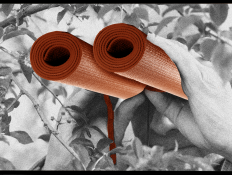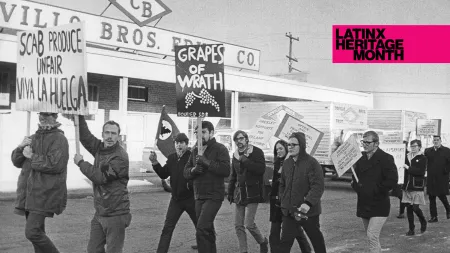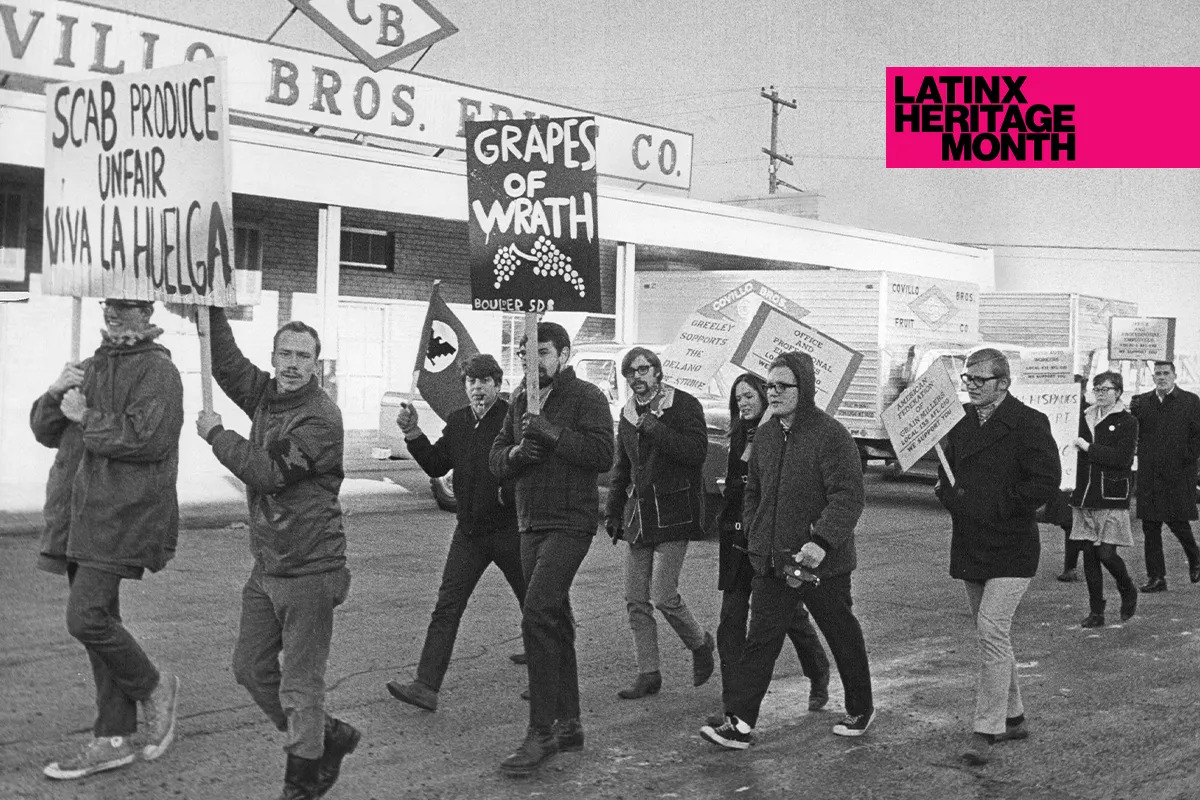
The Chicano Art Movement represents a kaleidoscopic convergence of aesthetics and politics. When examined at a distance, it can be misunderstood as a singular, cohesive movement with a clearly defined beginning and end. Any effort to encapsulate the Chicano Art Movement, however, must insist on recognizing the multiplicity and simultaneity of artistic visions that came out of it, as well as a porousness that facilitated solidarity with artists and groups beyond the Mexican American community. This overview focuses primarily on creative production during the mid-1960s and ’70s as a way to parallel the activities of el Movimiento, also known as the Chicano Civil Rights Movement. (Throughout this article, “Chicano” is used when referring to artwork created during the historic era of el Movimiento in order to signal the exclusion that women and LGBT+ artists experienced, while “Chicana/o/x” indicates reference to a contemporary context.)
Farmworkers’ strikes that Cesar Chavez and Dolores Huerta led in 1965 before the formation of the United Farm Workers (UFW) served as a significant catalyst for the building of a Chicano movement and accompanying forms of artistic production. Other struggles within Mexican American communities continued to shape the direction of el Movimiento, including the 1968 student walkouts in East Los Angeles and Chicago in response to discriminatory educational conditions, protests against the Vietnam War led by the National Chicano Moratorium in 1970, and struggles to restore land rights for Hispano New Mexicans led by Reies Lopez Tijerina. In 1969 the Chicano Youth Liberation Conference, organized by Rodolfo “Corky” Gonzales, convened student activists from throughout the United States in Denver, solidifying a cohesive sense of Chicano identity, and galvanizing students nationwide to advocate for themselves through large-scale demonstrations.
Los Angeles Times journalist Rubén Salazar notably defined a Chicano as a “Mexican-American with a non-Anglo image of himself.” The adoption of the term Chicano as an alternative to Mexican American responded to expectations of cultural assimilation with a defiant reclaiming of a term that originated in the early 20th century as an insult. Emerging in conjunction with el Movimientoduring the 1960s, self-determination and cultural reclamation underscored the creation of political works throughout the Chicano Art Movement. Although Mexican American artists were active in the United States prior to el Movimiento, this interest in cultural reclamation, the assertion of a politicized identity, and a departure from Eurocentric aesthetic ideals distinguished this generation of Chicano artists from their predecessors.
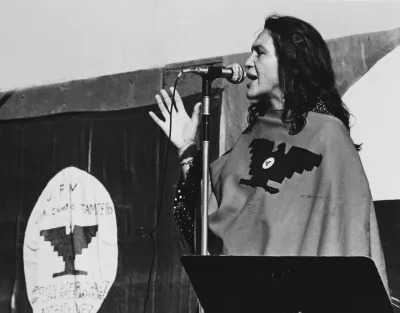
Image Production as Call to Action
The UFW acted as an early catalyst for Chicano art production as a tool for movement building. In 1965 Luis Valdez founded El Teatro Campesino in California’s Central Valley, and produced short performances for farm workers laboring in the fields. El Teatro Campesino served as an extension of the UFW’s organizing efforts, hiring visual artists like Carlos Almaraz to paint backgrounds and sets. The UFW also published Chicano graphics, establishing Taller de Gráfica Popular to put out prints, calendars, and other material featuring UFW imagery. Chicano artists such as Xavier Viramontes and Carlos Cortez produced prints and posters amplifying calls for UFW boycotts both independently and in collaboration with the UFW.
Numerous Chicano artists, including Rupert Garcia and Malaquias Montoya, began producing work in conjunction with el Movimiento that addressed pressing issues, such as labor struggles, police brutality, state violence, the Vietnam War, and deportations. Printmaking and image production were essential tasks for ensuring that information could be shared quickly, effectively, and widely. Publications such as El Malcriado, La Raza, and El Grito del Norte drew on the influence of the 1960s counterculture underground press and the Black Panther Party’s official newspaper. A cohort of graphic designers, illustrators, artists, and photographers produced images for these publications that made tangible Chicanos’ lived realities and struggles for justice. The satirical cartoons that Andrew Zermeño created for El Malcriado, which ran between 1964 and 1976, showed the travails of Don Sotaco, a Mexican American farmworker, who was exploited by his boss, Patroncito, and El Coyote, the labor contractor, as a way to bring awareness to the labor conditions farmworkers experienced.
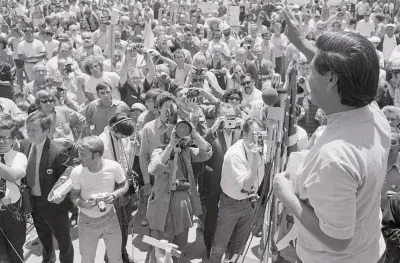
Maria Varela, a volunteer photographer for La Raza, lived in the Midwest and was recruited by the Student Nonviolent Coordinating Committee to record civil rights efforts in the South. Throughout the ’60s, she traveled extensively with the organization, documenting marches and police brutality against protesters. In 1968 she joined Reies Lopez Tijerina’s organization, Alianza Federal de Mercedes, and began documenting significant events in el Movimiento, such as the 1969 Chicano Youth Liberation Conference in Denver, as well as scenes of Hispano communities in New Mexico.
Documentary and street photography served as a counterpart to Chicano photojournalism, and artists such as Oscar Castillo, George Rodriguez, and Luis C. Garza moved between these genres. (La Raza’s archives of some 25,000 images, created during the paper’s run between 1967 and 1977, are now housed at the Chicano Studies Research Center at UCLA; they were the subject of a major exhibition, cocurated by Garza, at the Autry Museum of the American West in 2017.) Chicano photographers served as chroniclers of not only significant events, but of the cadences of contemporary life: Louis Carlos Bernal’s photographs of communities in Arizona, New Mexico, Texas, and California seek out poignant moments in everyday life that express a sense of intimacy with his subjects.
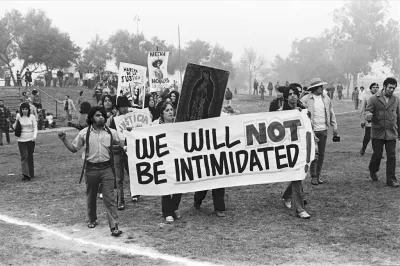
Shared Struggles, Distinct Expressions
Much like el Movimiento, Chicano artists were active across a broad geographic range. Although many artists worked throughout the Southwest in Arizona, California, Colorado, New Mexico, and Texas, significant Chicano cultural production also took place in Michigan, Chicago, and Seattle. Numerous works and political actions advocated for cross-ethnic, racial, and transnational solidarity, and Chicano organizers often collaborated with Black activists, including the Black Panther Party, which served as a reference for the establishment of the Brown Berets. Groups in Los Angeles, Chicago, Seattle, and Austin participated in walkouts and marches, advocated for more equitable public education, and opened health clinics that served Mexican American communities. Additionally, despite the term “Chicano” referring to Mexican American identity, several notable figures within the history of Chicano art, such as Mario Torero, Herbert Sigüenza, and Sister Karen Boccalero, are not Mexican American, suggesting that identification with “Chicano” is not bound strictly by ethnicity but by a commitment to the societal issues that el Movimiento sought to remedy.
Despite Chicano art’s identification with a broader movement, the art itself is heterogeneous, often specific to the various locales where a given cohort of artists was based. Within California alone, the Chicano Art Movement has varied and distinctive aesthetics in the state’s major cities: San Diego, Los Angeles, San Francisco, Sacramento, Fresno, and Bakersfield. And outside California, the art scenes in the Southwest, Texas, and Chicago were equally varied. Although recurring motifs and iconography link distant sites, numerous artists such as Chicago-born muralist Ray Patlán met and collaborated with contemporaries outside their respective geographic regions, resulting in a dense nonlinear web of resonance and influence. (The landmark 1990 exhibition “Chicano Art: Resistance and Affirmation, 1965-1985,” called “CARA” for short, historicized 20 years of Chicano creative production and featured works by 180 artists, with an emphasis on el Movimiento’s geographic diversity.)
The revolutionary rhetoric of el Movimiento spurred the formation of numerous Chicano art collectives, such as East LA’s Los Four and ASCO, Chicago-based Movimiento Artístico Chicano (MARCH), Movimiento Artístico del Rio Salado (MARS) in Phoenix, and the Texas-based groups Con Safo and Los Quemados. Collectives such as these pushed against the mythology of the solitary artist and often produced work in a wide range of media and, in some cases, included writers and art historians. In Sacramento, the Royal Chicano Air Force supported a broad range of community-based cultural activities, spanning music, poetry, visual arts production, and a gallery and bookstore, in addition to launching a free breakfast program for children. Mujeres Artistas del Suroeste, founded by Santa Barraza, provided a network that created opportunities for Chicanas in Texas to produce and exhibit their artwork.
Many Chicana/o artists were also engaged in building structures to support their work in response to a lack of institutional support, assuming the roles of not just artists, but critics, art historians, curators, and arts administrators. Throughout the United States, the formation of Chicano art collectives coincided with the creation of Chicano cultural organizations that were frequently founded and led by artists, such as Mechicano Art Center and Self Help Graphics & Art in Los Angeles, Galería de la Raza in San Francisco, and Centro Cultural Aztlan in San Antonio, among others, offering dedicated space for the creation and exhibition of Chicano art at a time when mainstream institutions excluded this work.
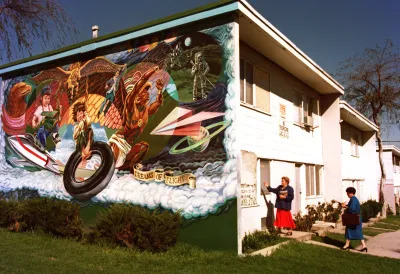
Chicanismo and Imagined Mythologies
El Movimiento cohered around the establishment of a shared nationalistic identity rooted in Mesoamerican culture known as “Chicanismo,” which offered an alternative to Chicanos’ experience of existing between Mexican and American cultures, but never feeling a full sense of belonging in either. Through engagement with this past, Chicano artists located themselves within an expansive history that preceded colonialism, suggested ties to indigeneity, and offered a deep well of iconography for adaptation within a contemporary context. The reclaiming of the Southwestern US as Aztlán, the mythic homeland of the Aztecs, inverted Chicanos’ and Mexican Americans’ relationship to the US-Mexico border. For example, widespread misconceptions that all Mexican Americans and Chicanos had recently migrated to the United States overlooked the impact of the 1848 Treaty of Guadalupe Hidalgo’s designating more than 50 percent of Mexican territory as part of the US, including what later became the states of California, Arizona, Nevada, Utah, Colorado, New Mexico, and part of Wyoming. As a result, this invocation of Aztlán asserted not only that Chicanos have always been present on the land now known as the US, but that the border itself had crossed them, and not the inverse.
The UFW logo offers an early reference to Mesoamerican culture in Chicano art. Developed in 1962 by Cesar and Richard Chavez, the logo features a semiabstract black eagle that references the myth of an eagle holding a serpent landing on a nopal (prickly pear) that led to the establishment of Tenochtitlán as the capital of the Aztec empire. Additionally, the eagle’s geometric form recalls the architecture of a stepped pyramid. This reclaiming of a Mesoamerican past drew upon the Mexican government’s embrace of mexicanidad in state-sponsored cultural productions during the Mexican Revolution, which embraced mestizaje, or ethnic and cultural mixing of Spanish, Indigenous, and African peoples, as part of the creation of a new national identity. Within both mexicanidad and Chicanismo, Mesoamerican culture served as a malleable touchstone to anchor identity, rather than provide a fixed historical reference point.
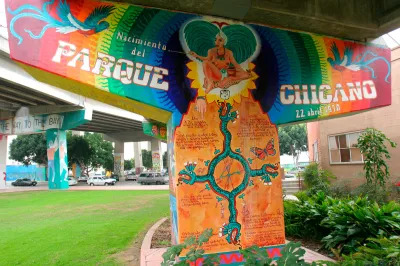
Inventing a New Iconography
In addition to claiming the Mesoamerican past, Chicano artists looked to historical figures and cultural production of the Mexican Revolution, embracing figures such as Emiliano Zapata, and women soldiers known as adelitas, and studying the works of Mexican artists such as Los Tres Grandes (David Alfaro Siqueiros, Diego Rivera, Jose Clemente Orozco), Frida Kahlo, and the printmaker Jose Guadalupe Posada. Chicano artists also critically reexamined stereotyped figures, such as the pachuco and pachuca, and retold current and historic events through artworks that questioned hegemonic narratives. Many early Chicano artworks featured imagery of Mexican revolutionaries and Aztec warriors and deities, such as Quetzalcoatl, and references to contemporary struggles in depictions of the UFW flag or farmworkers.
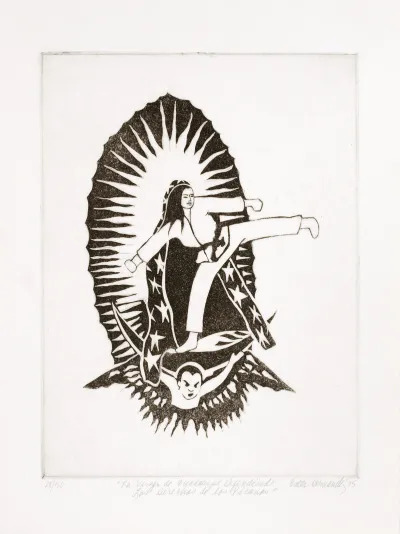
Though machismo prevailed in Chicano art circles, Chicana artists produced work that reflected the complexity of their own experience, reimagined cultural representations of femininity, and recovered historical figures such as Sor Juana Inés de la Cruz and La Malinche. Notably, Yolanda López, Ester Hernández, and Patssi Valdez reclaimed imagery of the Virgin of Guadalupe, showing the sacred icon as an embodied figure who can run, practice karate, and appear as ordinary women. Queer artists such as Mundo Meza, Teddy Sandoval, Joey Terrill, and Robert “Cyclona” Legorreta witnessed the Gay Liberation Movement and produced experimental and alternative iconographies that positioned them as both Chicano and queer while interrogating the exclusion of both identities, as seen in Terrill’s “Clones” series and Sandoval’s series of portraits that reclaimed the homophobic slur “maricón” by picturing his subjects wearing T-shirts, made by Terrill, with the term printed across the chest.
An aesthetic approach distinctive to Chicano art is the strategic usage of materials and imagery drawn from the experiences of working-class Mexican Americans. In 1989, Tomás Ybarra-Frausto theorized this approach in his essay, “Rasquachismo: A Chicano Sensibility,” which reframes rasquache, a classist term, as a site of empowerment and inventiveness. Most significantly, Ybarra-Frausto argues that rasquachismo cannot be reduced to a set of stylistic qualities, but that it is emblematic of a specific attitude and taste. In 1992, Amalia Mesa-Bains wrote “Domesticana: the sensibility of Chicana rasquache,” which articulated the significance of aesthetic practices by Chicanas that engage the space of the home as a critical response to not only dominant culture, but gendered expectations within Mexican American communities as well. In the decades following their publication, rasquachismo and domesticana remain generative frameworks that artists, scholars, and curators continue to elaborate on and engage.
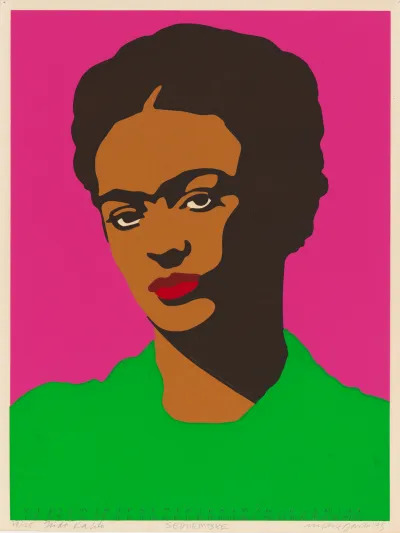
Another enduring expression of Chicano artists’ engagement with the past is the observation of Día de los Muertos (Day of the Dead). Beginning in the 1970s at Self Help Graphics & Art in East Los Angeles and Galería de la Raza in San Francisco, artists began to research traditions related to Día de los Muertos and adapt them to a contemporary context, creating ofrendas (offerings) and papel picado (cut paper) decorations, and organizing processions. In San Francisco, teacher and activist Yolanda Garfias Woo taught children and the general public about Día de los Muertos traditions starting in the late 1960s. Garfias Woo worked with artists at Galería de la Raza to start an annual Día de los Muertos celebration; the one in 1978 was notably dedicated to Frida Kahlo, and featured an ofrenda that was a collaboration between René Yañez, Carmen Lomas Garza, Amalia Mesa-Bains, and other artists. This piece departed from the ornate form that would typically be created for the occasion, and more closely resembled an intimate sacred space within the home, simultaneously speaking to the expansion and adaptation of a traditional form and recovering a significant cultural touchstone. Tradition and reinvention often melded in the processions organized by Self Help Graphics in the ’70s, in which participants dressed as calacas (skeletons) marched alongside adorned lowriders.
The influence of Mexican art on Chicano muralists is visible in such motifs as portraits of significant figures, political allegory, and references spanning historical eras. Chicano artists Judith F. Baca and Emanuel Martinez traveled to Mexico to study with Taller Siqueiros. After Martinez returned to Colorado, he painted his first mural, La Alma/The Soul (1978), near the housing projects in the La Alma Lincoln Park neighborhood in Denver. In 1974 Baca began work on The Great Wall of Los Angeles, a monumental mural depicting a multi-perspectival history of California painted on the concrete sides of the Tujunga Wash segment of the Los Angeles River. The half-mile-long Great Wall, which originated as a project to beautify the site, notably engaged a wide range of collaborators, including youths, other artists, and an array of experts on California history. (The Great Wall is currently undergoing an expansion to bring its imagery up to the present, with a $5 million grant from the Mellon Foundation; an exhibition at the Los Angeles County Museum of Art that ended this past July featured Baca and her team painting several of these new panels on-site.)
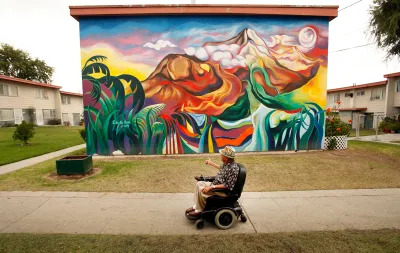
Much like The Great Wall, many early Chicano murals were painted in an effort to create vibrance in overlooked environments, including residential contexts, such as Estrada Courts in Boyle Heights, in East Los Angeles, and Balmy Alley in the Mission District of San Francisco. In other sites, such as Chicano Park in San Diego and Lincoln Park in El Paso, Texas, artists painted murals on structures supporting the freeways in order to reclaim space for the communities residing there. The Mujeres Muralistas, a group of Chicana and Latina painters active in San Francisco, contradicted assertions that women could not handle the physical demands of mural painting and expanded the visual lexicon of imagery depicted in murals with scenes of women, food, and families. Additionally, ASCO, a collective that disidentified with aspects of the Chicano art movement, adopted a satirical approach that embraced political action through avant-garde performance, dressing as murals that had become bored and walked away from a wall, in Walking Mural (1972), and protesting the exclusion of Chicano art at LACMA with Spray Paint LACMA (1972).
For Chicano artists, this rediscovery, reclamation, and reinvention of the past offered a corrective to the history (and art history) they learned in educational settings, which privileged a Eurocentric viewpoint and rigidly observed a corresponding aesthetic hierarchy in which painting and sculpture were valued above all else. Although Chicano artists drew upon a wide range of formal and stylistic languages throughout their work, among them abstraction, Conceptualism, Minimalism, Pop art, psychedelia, and punk (among others), the movement not only called for the creation of new imagery and iconography, but invited a reconsideration of which aesthetic forms were relevant and valuable. In the decades following el Movimiento, the ideological commitments and political identification that animated the early years of the Chicano Art Movement have continuously evolved, with veterano and emerging artists alike more recently identifying as Chicano/a/x. In doing so, they continue to expand and redefine the contours of Chicanx art. This ongoing work of reimagining runs concurrently with scholarly efforts to comb through tangled historical threads, and in doing so, recover unseen archives, narratives, and dimensions of Chicanx art history.
The Year in Latinx Art: Icons Receive Their Due as Mid-Career and Emerging Artists Get Spotlights
Outside the White House, rafa esparza Works Through Physical and Bureaucratic Constraints
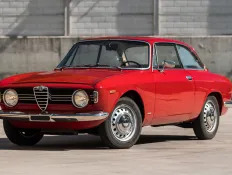
Why the Alfa Romeo Giulia Sprint GT Is the Quintessential Italian Sports Car
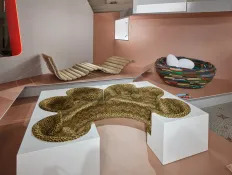
Les Arts Décoratifs Gets Intimate With New Exhibition
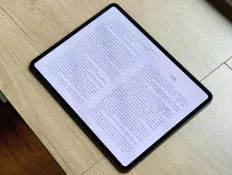
Concept shows Apple Books+ would be a killer addition to Apple One
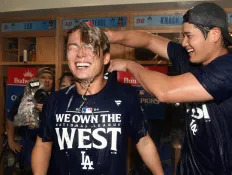
Money Talks as Mets, Dodgers, Yankees Advance in MLB Playoffs
